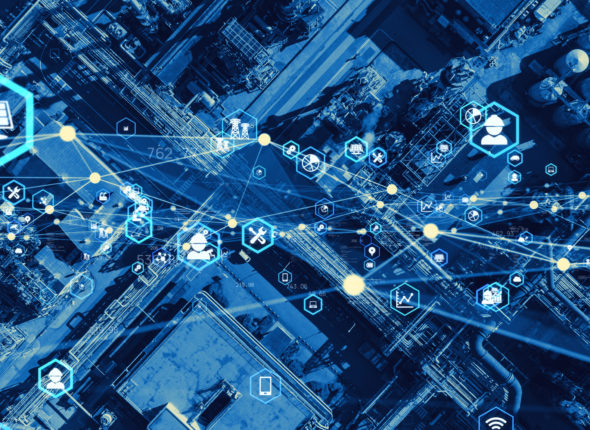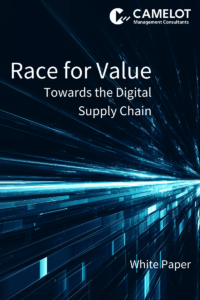Many supply chains lack basic functionalities, as they were designed a while back and have been operated over long stretches since, without continuous improvements. They now hit a reality that is characterized by a previously unknown level of volatility and uncertainty.
Making supply chains ready for current challenges means incorporating learnings from the past years and moving towards a more resilient and sustainable post-Covid-19 supply chain organization. What does this mean for supply chain planning?
The CAMELOT Editorial Team talked to our supply chain expert Christian Kroschl about his vision for future supply chain planning.
Christian, what’s wrong with today’s supply chain planning?
Many of our customers face huge challenges in their supply planning. Supply chain management requirements such as end-to-end visibility are not standard yet. We see a strong need for new resilience concepts to face changed customer demands, disruptions in transport infrastructures or missing transport capacity as well as shortages in e.g., processors.
As I outlined in a previous blog, many companies still struggle with the same challenges as in the last decades. Demand variabilities from functional and local silos, forecast errors, or end-to-end misalignment of supply parameters are passed down the entire supply chain node by node. Digitalization and disruptive technologies are simply not implemented yet to make a difference.
How do companies best approach improvements in their supply chain organizations?
From our experience, supply chain organizations need an approach that focuses on improving supply chain planning basics, prioritized by strategic trends and goals. In this way, they can implement new functionalities and quickly solve their most pressing needs and benefit from new trends. We see a handful of trends companies should consider: from process adaptions and new technologies to segmented networks and end-to-end accountability. In our customer projects we discuss these supply chain trends in detail and also convey a vision of tomorrow’s supply chains.
What does your supply chain planning vision involve?
At CAMELOT, we envision a self-regulating supply chain built on modern technologies like data science and neural networks. These technologies open the way to an automated decision support in supply chain planning. We see automated decision support especially in operational tasks like automated replenishment triggers and demand-dependent adaption of inventory buffers. Here is an opportunity for decision-making that combines the insights from previous data, incorporating external data sources, and still leaves room for human intuition and experience.
What role does technology play?
Technology is a powerful enabler, as it helps to solve problems on a scale that was unimaginable ten years back. Take blockchain, for example: it opens opportunities for traceability that we could only achieve with huge paper trails before.
Thus, technology helps to adapt processes and drive new strategies. Let’s picture a central control tower supply chain planning process: this process can only be adopted and realized by a technology support which allows for early detection of e.g. supply issues with related customer dependencies In addition, the process needs a technology which supports quick simulation of alternative scenarios evaluated by relevant KPIs to support decision making.
Another trend you mentioned is end-to-end accountability.
Yes. End-to-end accountability means that supply chain decisions are driven and controlled by overall optimizing KPIs. There is an end-to-end accountability for supply chain performance, which we need to overcome silo optimization. We often find that conflicting KPIs – e.g., production measured by output maximation, production planning by change-over-time reduction, network planning by minimizing inventory levels and customer service by high service level achievement – establish conflicting optimizations for each department. Thus, KPIs need to be harmonized and end-to-end supply chain organization should support to achieve overall company objectives and strategies.
If, for example, a company follows the strategy to be a low-cost provider, the end-to-end supply chain organization should focus on minimizing cost while achieving specific service level. In the case of a company that sets out to achieve the highest service level, the end-to-end supply chain strategy aims to achieve a set-up that maximizes service level achievement at specific cost boundaries.
From your experience, what is the most pressing issue for supply chain leaders?
There are various challenges that are keeping supply chain strategists busy, for example an increasing risk exposure of supply chains caused by climate change and geo-political conflicts, or the pressure to act from local legislation like the German “Lieferkettengesetz”. The topics of supply chain resilience and supply chain risk management are seeing a major revival just now.
As a reaction to the challenges posed by Covid-19?
Yes, but the pandemic is just one of many incidents. Studies by several institutions confirm that the impact and frequency of disruptions have increased for global supply chains. According to insurance industry tracking of disruptions, the annual number of natural catastrophes has almost doubled in the last 10 years [1]. And the occurrence of other disruptions such as malware infections has even increased more than 50 times in a similar time horizon [2] – to give you just two examples. So, it is not surprising that we observe a rising need for supply chain resilience. The concept has been around for some 15 years now, but only few organizations have managed to implement it in their supply chains.
The benefits are obvious. How should supply chain leaders approach the topic?
The first step is to accept that we live in an uncertain world: nobody can stop a volcano from erupting! But supply chain leaders can leverage technology to understand the dynamics that drive supply chain performance. First, they need to assess the vulnerabilities in their supply chain network. Then they can define and integrate resilient strategies in supply chain design and planning principles. Finally, they can enable continuous risk-aware and resilient planning.
Thank you very much for this interview, Christian.
[1] Natural disaster risks: Losses are trending upwards | Munich Re
[2] 2021 Cyber Security Statistics: The Ultimate List Of Stats, Data & Trends | PurpleSec

